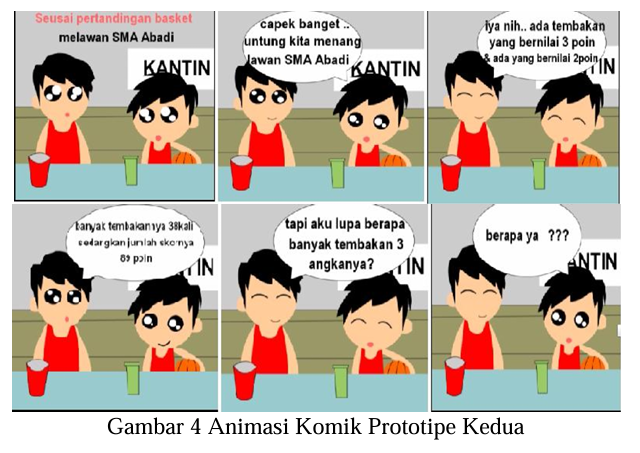Main Article Content
Abstract
This study is a development research which aims to: (1) generate story problems by using comic animation are valid and practical, (2) know the potential effects story problems by using comic animation to know the problem solving ability in class X Kusuma Bangsa Senior High School. The subject of this research is 27 students of the X.6 grade student of Kusuma Bangsa Senior High School. The data collecting technique used is walk through to know the validity of the the problem of its content, construction, and language; documentation used to know the practicality of the problem; and test used to know the potential effect of story problem of Linear Equation System by using comic animation to know the problem solving ability of the 10th grade student of Senior High School. The result concludes that (1) this research is resulted in a product story problem of Linear Equation System by using comic animation as much as 10 questions to know the valid and practical problem solving ability of the 10th grade student. The validity is indicated from the result of the validity assessments and problem analysis. The practicality is indicated from the small group and field test try out result which most of the student can understand the problem well. (2) Prototype developed has the potential effect to student problem-solving abilities. This is illustrated from the student's ability to understand the problem and then make a mathematical model of the problem, choosing an appropriate strategy to solve the problem, and explain the results obtained in accordance with the problem.
Keywords
Article Details
Copyright (c) 2025 Henny Fitriani

This work is licensed under a Creative Commons Attribution 4.0 International License.
This journal provides immediate open access to its content on the principle that making research freely available to the public supports a greater global exchange of knowledge.
All articles published Open Access will be immediately and permanently free for everyone to read and download. We are continuously working with our author communities to select the best choice of license options, Creative Commons Attribution-ShareAlike (CC BY-NC-SA).
References
- Akker, J. Van den. 1999. Principles and methods of development research. In: J. Van den Akker, R.Branch, K.Gustafson, N.Nieveen and Tj. Plomp (eds), Design Methodology and Development Research. Dordrecht: Kluwer.
- Cho, Hoyun. 2012. Using of Comics to Increase Interest and Motivation. (online). Tersedia: http://www.icme12.org/upload/UpFile2/WSG/0264.pdf. Diakses: 26 Desember 2012
- Depdiknas, 2006. Kurikulum tingkat satuan pendidikan standar kompetensi SMA. Jakarta: Depdiknas.
- Fatra, Maifalinda. “Penggunaan KOMAT (Komik Matematika) pada pembelajaran matematika di MI”. Jurnal ALGORITMA Vol.3 No. 1 Juni 2008. (online). Tersedia: http://isjd.pdii.lipi.go.id/admin/j urnal/31085973.pdf. Diakses pada 18 Mei 2012
- Lopez, Lurdes. 1996. Helping at-risk students solve mathematical word problems through the use of direct instruction and problem solving strategies. Thesis. (Online). Tersedia: http://etd.fcla.edu/CF/CFE00020 95/Lopez_Lurdes_200804_MAS T.pdf.pdf. Diakses pada 21 Juni 2012.
- Maulana. Matematikomik sebagai alternative media dalam pembelajaran matematik untuk meningkatkan motivasi dan prestasi belajar siswa. (online). Tersedia: http://file.upi.edu/Direktori/KD- SUMEDANG/198001252008121002-MAULANA/Artikel/Matematikomik.pdf. Diakses pada 22 Juli 2012.
- Muliyardi. 1999. Penyajian Soal Cerita Matematika dalam Bentuk Komik di Kelas I Sekolah Dasar. Tesis : IKIP Surabaya. (tidak dipublikasikan)
- Muliyardi. 2002. Penggunaan komik dalam pembelajaran matematika di Sekolah Dasar.” Jurnal Matematika dan Pembelajarannya, Juli 2002, Tahun VIII, hal. 515 – 519.
- Nugroho, Tri Adjie. 2009. Penerapan pembelajaran matematika realistik untuk meningkatkan motivasi dan hasil belajar siswa kelas X SMK Negeri 1 Pogalan. (online). Tersedia: http://library.um.ac.id/ptk/index. php?mod=detail&id=48140. Diakses pada 15 Mei 2012.
- Soedjadi, R. 1995. Evaluasi hasil belajar dalam rangka meningkatkan mutu pendidikan. IKIP Surabaya.
- Sugiman, dan Yaya S. Kusumah. Dampak Pendidikan Matematika Realistik terhadap Peningkatan Kemampuan Pemecahan Masalah Siswa SMP. Journal on Mathematics Education, Juli 2010, hal. 41 – 51.
- Syah, M. 1995. Psikologi pendidikan: Suatu Pendekatan Baru. Bandung: Remaja Rosda Karya.
- Zulkardi. 2003. Realistic Mathematics Education (RME) atau Pendidikan Matematika Realistik Indonesia (PMRI). Makalah disajikan dalam Lokakarya Nasional Pendidikan Matematika pada tanggal 21 Agustus 2003, di PPS UNSRI.
- Zulkardi. 2006. Formative Evaluation : What, Why, When, and How. Disertasi. Tersedia pada http://www.oocities.org/zulkardi/books.html. Diakses pada 30 Juni 2012.
References
Akker, J. Van den. 1999. Principles and methods of development research. In: J. Van den Akker, R.Branch, K.Gustafson, N.Nieveen and Tj. Plomp (eds), Design Methodology and Development Research. Dordrecht: Kluwer.
Cho, Hoyun. 2012. Using of Comics to Increase Interest and Motivation. (online). Tersedia: http://www.icme12.org/upload/UpFile2/WSG/0264.pdf. Diakses: 26 Desember 2012
Depdiknas, 2006. Kurikulum tingkat satuan pendidikan standar kompetensi SMA. Jakarta: Depdiknas.
Fatra, Maifalinda. “Penggunaan KOMAT (Komik Matematika) pada pembelajaran matematika di MI”. Jurnal ALGORITMA Vol.3 No. 1 Juni 2008. (online). Tersedia: http://isjd.pdii.lipi.go.id/admin/j urnal/31085973.pdf. Diakses pada 18 Mei 2012
Lopez, Lurdes. 1996. Helping at-risk students solve mathematical word problems through the use of direct instruction and problem solving strategies. Thesis. (Online). Tersedia: http://etd.fcla.edu/CF/CFE00020 95/Lopez_Lurdes_200804_MAS T.pdf.pdf. Diakses pada 21 Juni 2012.
Maulana. Matematikomik sebagai alternative media dalam pembelajaran matematik untuk meningkatkan motivasi dan prestasi belajar siswa. (online). Tersedia: http://file.upi.edu/Direktori/KD- SUMEDANG/198001252008121002-MAULANA/Artikel/Matematikomik.pdf. Diakses pada 22 Juli 2012.
Muliyardi. 1999. Penyajian Soal Cerita Matematika dalam Bentuk Komik di Kelas I Sekolah Dasar. Tesis : IKIP Surabaya. (tidak dipublikasikan)
Muliyardi. 2002. Penggunaan komik dalam pembelajaran matematika di Sekolah Dasar.” Jurnal Matematika dan Pembelajarannya, Juli 2002, Tahun VIII, hal. 515 – 519.
Nugroho, Tri Adjie. 2009. Penerapan pembelajaran matematika realistik untuk meningkatkan motivasi dan hasil belajar siswa kelas X SMK Negeri 1 Pogalan. (online). Tersedia: http://library.um.ac.id/ptk/index. php?mod=detail&id=48140. Diakses pada 15 Mei 2012.
Soedjadi, R. 1995. Evaluasi hasil belajar dalam rangka meningkatkan mutu pendidikan. IKIP Surabaya.
Sugiman, dan Yaya S. Kusumah. Dampak Pendidikan Matematika Realistik terhadap Peningkatan Kemampuan Pemecahan Masalah Siswa SMP. Journal on Mathematics Education, Juli 2010, hal. 41 – 51.
Syah, M. 1995. Psikologi pendidikan: Suatu Pendekatan Baru. Bandung: Remaja Rosda Karya.
Zulkardi. 2003. Realistic Mathematics Education (RME) atau Pendidikan Matematika Realistik Indonesia (PMRI). Makalah disajikan dalam Lokakarya Nasional Pendidikan Matematika pada tanggal 21 Agustus 2003, di PPS UNSRI.
Zulkardi. 2006. Formative Evaluation : What, Why, When, and How. Disertasi. Tersedia pada http://www.oocities.org/zulkardi/books.html. Diakses pada 30 Juni 2012.

